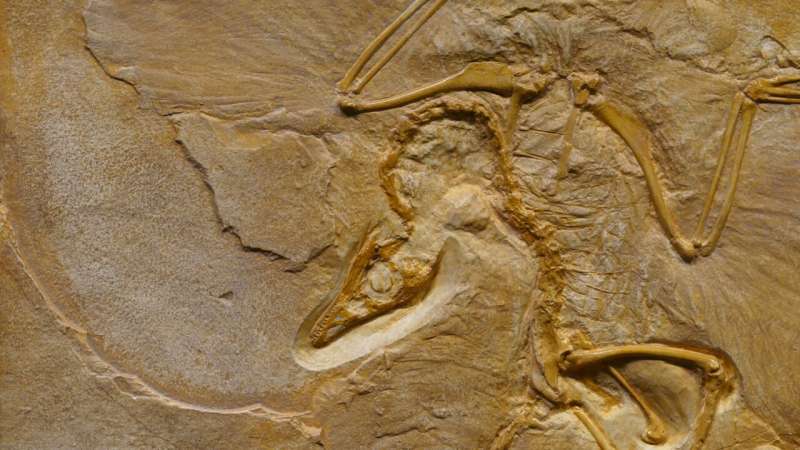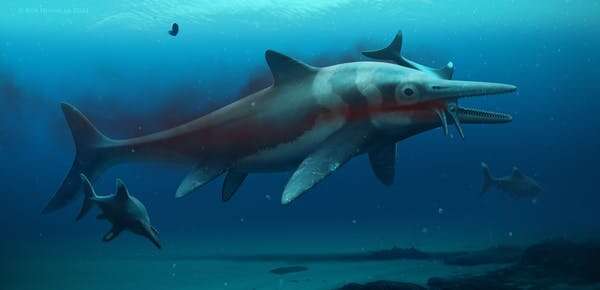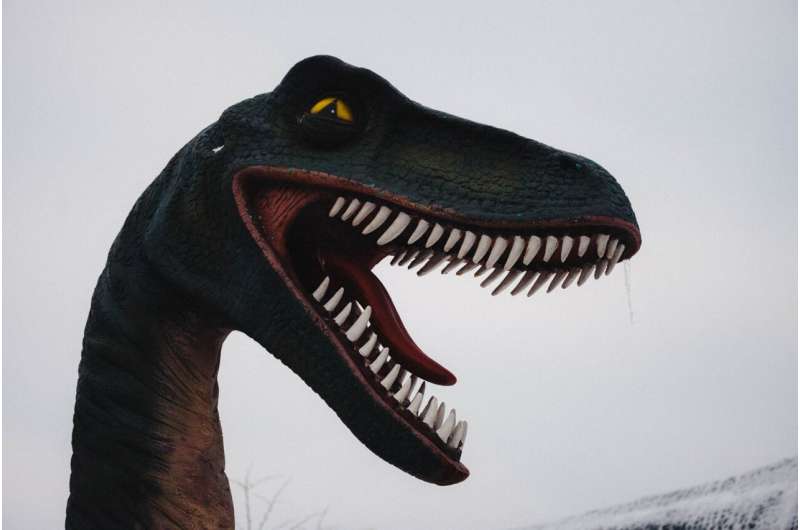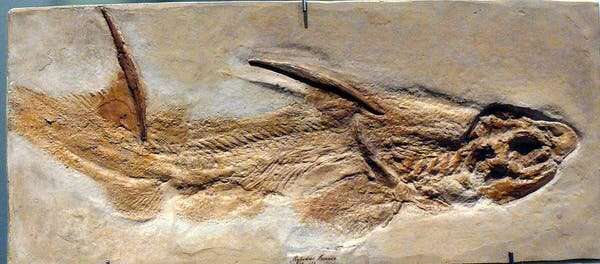Plesiosaurs, pliosaurs, hybodonts: Looking back at three prehistoric predators of the Jurassic seas

The fossilized remains of a gigantic ichthyosaur, colloquially known as a "sea dragon," were recently uncovered at the Rutland Water Nature Reserve in the UK. Measuring at least ten meters in length and with a skull weighing roughly one ton, it's the largest, most complete ichthyosaur of its kind found to date in Britain.
The skeleton was discovered by Joe Davis of the Leicestershire and Rutland Wildlife Trust in February 2021. It was carefully excavated in August and September 2021 by a team of paleontologists assembled from around the UK (including myself), led by ichthyosaur expert Dr. Dean Lomax and palaeontological conservator Nigel Larkin.
Based on analysis of microscopic fossils from the surrounding sediment, we were able to ascertain that the Rutland ichthyosaur is roughly 181.5 to 182 million years old. The creature's anatomy suggests it most likely belongs to the species Temnodontosaurus trigonodon. This would make it the first occurrence of this ichthyosaur species in the U.K.
It's a common misconception that ichthyosaurs were "swimming dinosaurs." But they were actually a group of marine reptiles which lived during the Mesozoic era (between 66 and 252 million years ago). As successful major predators, they were fundamental to Mesozoic marine ecosystems.
The number of ichthyosaur species peaked during the Triassic period (between 250 and 201 million years ago) and especially the Jurassic period (201 to 145 million years ago). But these were not the only predators patrolling the prehistoric seas. Let's dive in and take a look back at three other extinct sea creatures that dominated the Jurassic oceans.

Plesiosaurs
Plesiosaurs (meaning "near to lizard") were a group of large, long-necked marine reptiles that belong to the order Plesiosauria. These animals appeared in the Late Triassic period and became especially prevalent during the Jurassic period. They thrived until their disappearance in the Cretaceous–Paleogene extinction event, roughly 66 million years ago. Plesiosaurs existed in oceans across the world: in European seas and around the Pacific Ocean, including Australia, North America and Asia.
Plesiosaurs ranged in length from less than 2 meters to more than 17 meters. Some species had incredibly long necks, almost twice as long as the rest of their body.
Plesiosaurs had a broad, flat body, short tail, and four long fins which made this animal a strong swimmer. They also had a small head—but they were filled with sharp, pointed teeth to facilitate their carnivorous diet of fish and ancient squid-like molluscs. Like ichthyosaurs, plesiosaurs gave birth to live young. The first almost-complete skeleton of Plesiosaurus was discovered in 1823 at Lyme Regis, Dorset in the UK by pioneering paleontologist Mary Anning.

Pliosaurs
Pliosaurs (meaning "more lizard") are another group of Jurassic marine reptiles which belong to the order Plesiosauria. But unlike their long-necked plesiosaur cousins, these animals had short necks with a large, elongated head similar to crocodiles. Pliosaurs ranged from around four to ten meters in length, but could be up to 15 meters. Pliosaurs also had two pairs of powerful paddles and a relatively short tail.
During certain parts of the Jurassic period, they were the top predators of the ocean. The creature's powerful jaws contained sharp, conical teeth which they used to feed on fish, sharks, ichthyosaurs and other Plesiosauria.
This genus is represented by four species (R. cramptoni, R. propinquus, R. thorntoni and R. zetlandicus) and all currently known specimens have been discovered in Yorkshire and Northamptonshire in the UK. Like plesiosaurs, pliosaurs became extinct in the Cretaceous–Paleogene extinction event 66 million years ago.

Hybodont sharks
Hybodus (meaning "humped tooth") is an extinct genus of shark which first appears towards the end of the Permian period (260 million years ago). It became highly successful in the shallow Jurassic seas, away from the deep waters that plesiosaurs and pliosaurs inhabited.
This genus possessed streamlined, fusiform bodies (spindle-shaped, elongated and tapering at both ends) which enabled them to move quickly though the water. They also had two fins on their backs which would have helped them steer with precision. These opportunistic predators typically grew to roughly two meters long.
Hybodus consumed a wide variety of prey thanks to their teeth, which were arranged into two groups. At the front were sharp, pointed teeth which were useful for grabbing prey including fish and squid; while the back teeth were rounded and more suited for crushing the shells of crustaceans.
In fact, a specimen of Hybodus belonging to the species H. hauffianus from Holzmaden in Germany was found stuffed with belemnites (extinct cephalopod molluscs), suggesting that this creature died after overindulging on too many belemnite rostra (shells).
The hybodonts became extinct towards the end of the Late Cretaceous period, some 66 million years ago. The first fossilized Hybodus teeth were found in the UK around the mid-19th century, but remains including skeletons, isolated teeth and head and fin spines have now been recovered from Asia, Europe, Africa and North America.
Provided by The Conversation
This article is republished from The Conversation under a Creative Commons license. Read the original article.![]()




















